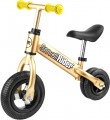Max. weight
The maximum rider weight that the bike can normally carry. This point is directly related to the age group (see above), however, bikes with the same age recommendations may differ in maximum load.
Of course, it is impossible to exceed the load specified by the manufacturer: even if an accident does not happen immediately, it can happen at any time. And ideally, you should choose a bike with a margin of weight — both in case of emergency situations, and taking into account the fact that the child will grow.
Wheel diameter
Bicycle wheel diameter is traditionally indicated in ". The overall height of the bike directly depends on this parameter, so each age category has its own wheel size - in accordance with the height of the young cyclist. However, cars of the same type and age group may differ in wheel diameter; this is especially pronounced among two-wheeled bicycles. In such cases, it is worth considering the following point: larger wheels behave better on rough roads and allow you to coast for a long time, but they are reluctant to accelerate and require more effort on the pedals; small wheels - on the contrary, they spin without much effort, but they hold speed worse and are more sensitive to pits and potholes.
Tricycles predominantly have a wheel diameter of
10 ", balance bikes -
12 ". In two-wheeled models, there are sizes in
14,
16,
18 and
20 ". Larger diameter wheels are no longer used in children's, but in teenage bicycles (they are listed in our catalog in the section with older bikes).
Wheels
The design of the wheels fitted to a bicycle and the materials used for the tyre/rim.
—
Inflatable rubber. Wheels with inflatable rubber tires — the same as those on full-size adult bicycles. Such wheels are quite demanding in terms of maintenance: their condition must be monitored and pumped up if necessary. In addition, even a small puncture in the tire makes it unusable and requires repair. On the other hand, this is the most advanced type of wheel in terms of performance: they perform well even on uneven roads, smooth out vibrations, provide good traction and are suitable for fast, dynamic riding. And servicing inflatable tires can be a good training for a young cyclist before switching to a teenage bike. That is why two-wheeled models for older age groups are mainly equipped with inflatable tires. However, this option can also be found in other varieties, including balance bikes and even three-wheeled ones (see "Type").
—
Rubber. Wheels with a solid rubber tire. Unlike the inflatable ones described above, such tires do not need to be inflated, and they are completely resistant to scratches and punctures. On the other hand, solid rubber wheels are less suitable for uneven roads and high loads. Therefore, they are found mainly among bicycles for the smallest, and in the age category from 5 to 8 years, such wheels are not used at all.
— Polyurethane. In design, such wheels
...are similar to solid rubber ones (see above), they differ only in the tire material — polyurethane (elastic synthetic material). Polyurethane is noticeably harder than rubber, so it is used mainly in tricycles, not designed for fast driving and uneven roads.
— Plastic. Wheels made entirely of plastic. The main advantage of this material is its low cost; in addition, it can be given almost any color. On the other hand, plastic is hard and not very durable, it is not suitable for uneven roads and high speeds. Therefore, such wheels are used only in tricycles and some balance bikes (see "Type").
— Plastic with rubber. A slightly improved version of the plastic wheels described above. In this case, the hard plastic is supplemented with a kind of tire analogue — a narrow rubber strip around the rim, where the wheel touches the ground while driving. This helps to soften the vibrations that inevitably occur even when driving on smooth asphalt, but this is essentially where these wheels differ from purely plastic ones — plastic with rubber is also used only in tricycles, where the wheels are not designed for significant loads.Cast wheels
In the context of children's bicycles,
alloy wheels refer to monolithic wheels made by injection molding. This is where they differ from traditional wheels, where the rim and hub are connected by spokes. Alloy wheels are typically stronger and more resistant to damage, and with fewer moving parts, they are easier to maintain.
Footrest
A special
stand on which the child can put his feet while sitting on a bicycle. It is found exclusively in three-wheeled models (see "Type") equipped with a parent handle (see above), and is another "pram" function: when the parent pushes the car, it is inconvenient and sometimes unsafe for the baby to keep his feet on the pedals. do not confuse this feature with a
bicycle footrest, which allows you to put the bike on your own without a stop.

